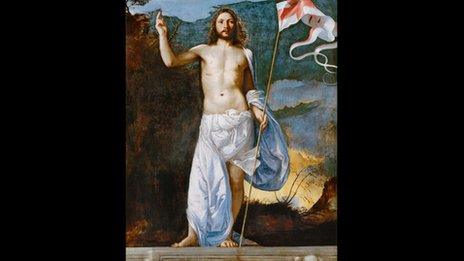Titian identified as Risen Christ artist
- Published

The Risen Christ is believed to have been painted around 1511
A painting held in a private collection in Europe has been identified as the work of Italian master Titian.
The 16th Century oil painting, The Risen Christ, is believed to have been executed around 1511 .
Writing in the Burlington magazine, art historian Artur Rosenauer from the University of Vienna, said it was "astonishingly well preserved".
"It is extremely rare for a hitherto unknown Titian to come to light," said Rosenauer.
The professor said he believes it was created for a brotherhood and intended for holy processions.
It belonged to the Von Bulow family in the 19th Century, and by Bernhard Heinrich von Bulow, chancellor of Germany, until his death in 1929.
The painting is subsequently believed to have travelled to South America and was then bought by its present owners, from Montevideo in Uruguay.
"Standing on the lid of his sealed tomb, the monumental figure of Christ is presented to the viewer in an attitude of 'heroica maesta'. His left hand holds the flag of the resurrection, while his right arm is raised in triumphant blessing," writes Rosenauer.
Tiziano Vecellio, better known as Titian, was the greatest painter of the Venetian school and one of Italy's most important High Renaissance artists.
He singlehandedly revolutionised nearly all aspects of painting and inspired future greats such as Rubens, van Dyck, Velazquez and Rembrandt.
Last year, his Diana and Callisto was saved for the nation, after a £45m ($71.7m) deal was agreed with its owner, the Duke of Sutherland.
The "supremely important" oil painting was bought with the help of £25m ($39.9m) from the National Gallery after a lengthy fundraising campaign.
Along with its partners National Galleries of Scotland, the gallery also saved sister piece Diana and Actaeon in 2009.
- Published8 November 2012
- Published7 March 2012
- Published28 January 2011